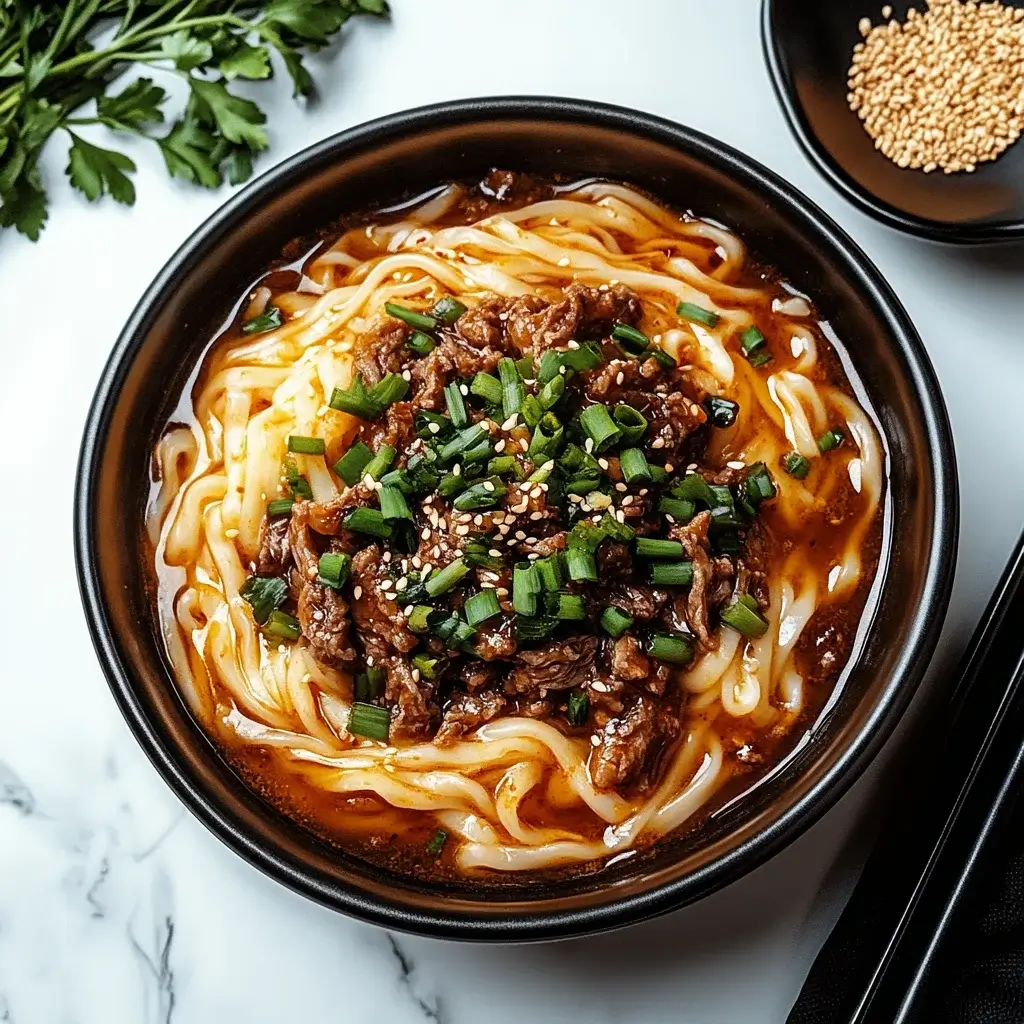
Introduction to Spicy Korean Gochujang Beef Noodles
There’s something magical about a dish that brings warmth and excitement to the table, and Spicy Korean Gochujang Beef Noodles does just that. Whether you’re racing against the clock after a long day or looking to impress friends with a burst of flavor, this recipe is your go-to. The combination of tender beef, vibrant vegetables, and that signature spicy gochujang sauce creates a symphony of taste that’s hard to resist. Plus, it’s quick to whip up, making it perfect for any night of the week. Let’s dive into this culinary adventure together!
Why You’ll Love This Spicy Korean Gochujang Beef Noodles
This dish is a game-changer for busy weeknights. It’s not just quick to prepare; it’s bursting with flavor that’ll make your taste buds dance. The spicy gochujang sauce adds a kick that elevates the humble beef and noodles into something extraordinary. Plus, it’s versatile! You can easily customize it with your favorite veggies or adjust the spice level. Trust me, once you try it, you’ll be hooked!
Ingredients for Spicy Korean Gochujang Beef Noodles
Gathering the right ingredients is the first step to creating a delicious dish. For Spicy Korean Gochujang Beef Noodles, you’ll need a mix of fresh and flavorful components. Here’s what you’ll need:
- Rice noodles: These are the base of the dish, providing a chewy texture that soaks up the sauce beautifully.
- Ground beef: A classic choice for protein, it adds richness and heartiness to the meal. You can also use ground turkey or chicken for a lighter option.
- Vegetable oil: This is used for sautéing, helping to bring out the flavors of the ingredients.
- Onion: Diced onions add sweetness and depth to the dish, enhancing the overall flavor profile.
- Garlic: Minced garlic is a must for that aromatic kick that makes everything taste better.
- Fresh ginger: A small amount of minced ginger adds a zesty warmth that complements the spice.
- Gochujang: This Korean chili paste is the star of the show, delivering heat and umami in every bite.
- Soy sauce: A splash of soy sauce brings saltiness and depth, balancing the sweetness of the honey.
- Sesame oil: Just a drizzle adds a nutty flavor that rounds out the dish perfectly.
- Honey: This natural sweetener helps to balance the heat from the gochujang, creating a harmonious flavor.
- Bell peppers: Sliced bell peppers add color and crunch, making the dish visually appealing and nutritious.
- Snap peas: These provide a fresh, crisp texture that contrasts nicely with the noodles.
- Green onions: Sliced green onions are perfect for garnish, adding a pop of color and a mild onion flavor.
- Sesame seeds: A sprinkle of sesame seeds on top adds a delightful crunch and a touch of elegance.
For those looking to switch things up, consider substituting ground beef with crumbled tofu or tempeh for a vegetarian version. You can also add more veggies like carrots or broccoli for extra nutrition and color. Remember, the exact quantities of these ingredients are listed at the bottom of the article for your convenience!
How to Make Spicy Korean Gochujang Beef Noodles
Now that you have all your ingredients ready, let’s dive into the cooking process. This is where the magic happens! Follow these simple steps to create a dish that’s bursting with flavor.
Step 1: Cook the Rice Noodles
Start by cooking the rice noodles according to the package instructions. Usually, this means boiling them in water for a few minutes until they’re tender but still have a bit of bite. Once done, drain them and set aside. This will be the base of your Spicy Korean Gochujang Beef Noodles, soaking up all that delicious sauce!
Step 2: Sauté the Onions
In a large skillet or wok, heat up the vegetable oil over medium-high heat. Add the diced onion and sauté for about 2-3 minutes until they soften and become translucent. This step is crucial; it builds the foundation of flavor for your dish. The aroma of sautéing onions is simply irresistible!
Step 3: Add Garlic and Ginger
Next, toss in the minced garlic and ginger. These two ingredients are the flavor powerhouses of this recipe. Cook them for about 1 minute until fragrant. You’ll know it’s ready when your kitchen starts to smell heavenly. This is the moment when your taste buds start to tingle with anticipation!
Step 4: Brown the Ground Beef
Now, it’s time to add the ground beef. Break it apart with a spatula as it cooks, ensuring it browns evenly. This should take about 5-7 minutes. You want it to be fully cooked and nicely browned. The beef will absorb all those wonderful flavors from the onions, garlic, and ginger, making every bite delicious.
Step 5: Mix in the Sauce
Once the beef is browned, stir in the gochujang, soy sauce, sesame oil, and honey. Mix everything well to combine. Let it simmer for about 2-3 minutes. This is where the magic happens! The sauce thickens and coats the beef, creating a rich, spicy flavor that’s simply mouthwatering.
Step 6: Add Vegetables
Now, add the sliced bell peppers and snap peas to the skillet. Cook for another 3-4 minutes until the vegetables are tender-crisp. You want them to retain some crunch for texture. The vibrant colors of the veggies will make your dish pop, making it as pleasing to the eyes as it is to the palate!
Step 7: Combine with Noodles
Finally, toss the cooked rice noodles into the skillet. Gently mix everything together, ensuring the noodles are well coated with that spicy gochujang sauce. This is the moment you’ve been waiting for! Serve hot, and watch everyone dig in with delight.

Tips for Success
- Prep all your ingredients before starting to cook. It makes the process smoother and more enjoyable.
- Don’t overcook the vegetables; they should be tender-crisp for the best texture.
- Adjust the gochujang to your spice preference. Start with less if you’re unsure!
- For extra flavor, let the sauce simmer a bit longer to deepen the taste.
- Garnish generously with green onions and sesame seeds for a beautiful finish.
Equipment Needed
- Large skillet or wok: Essential for sautéing and mixing everything together. A frying pan works too!
- Pot: For boiling the rice noodles. Any large pot will do.
- Spatula: Perfect for breaking up the beef and stirring the ingredients.
- Measuring cups and spoons: Handy for precise ingredient measurements.
Variations
- Vegetarian Option: Swap out ground beef for crumbled tofu or tempeh. This keeps the dish hearty while catering to plant-based diets.
- Extra Veggies: Add in carrots, broccoli, or zucchini for more color and nutrition. They’ll enhance the dish’s texture and flavor.
- Gluten-Free: Ensure your soy sauce is gluten-free, or use tamari as a substitute to keep it safe for gluten-sensitive eaters.
- Spice Level: Adjust the amount of gochujang to suit your heat preference. For a milder version, start with half the amount and taste as you go.
- Noodle Alternatives: Try using udon or soba noodles for a different texture and flavor profile. Each type brings its own unique twist!
Serving Suggestions
- Side Dishes: Pair with a simple cucumber salad or kimchi for a refreshing contrast.
- Drinks: Enjoy with a cold beer or a light, fruity soju to complement the spice.
- Presentation: Serve in deep bowls, garnished with extra green onions and sesame seeds for a vibrant look.
FAQs about Spicy Korean Gochujang Beef Noodles
Can I make Spicy Korean Gochujang Beef Noodles ahead of time?
Absolutely! You can prepare the beef and sauce in advance and store them in the fridge. Just cook the noodles fresh when you’re ready to serve. This makes for a quick meal on busy nights!
What can I substitute for gochujang?
If you can’t find gochujang, you can use a mix of miso paste and chili powder as a substitute. It won’t be exactly the same, but it will still add a nice depth of flavor.
How spicy is this dish?
The spice level of Spicy Korean Gochujang Beef Noodles can be adjusted based on your preference. Start with a smaller amount of gochujang and taste as you go. You can always add more if you like it hotter!
Can I use other types of noodles?
Definitely! While rice noodles are traditional, you can experiment with udon or even whole wheat spaghetti. Each type will give a different texture and flavor to the dish.
Is this dish gluten-free?
Yes, as long as you use gluten-free soy sauce or tamari, Spicy Korean Gochujang Beef Noodles can be a delicious gluten-free option. Just double-check your noodle package as well!
Final Thoughts
Cooking Spicy Korean Gochujang Beef Noodles is more than just preparing a meal; it’s about creating an experience that brings joy to your table. The vibrant colors, enticing aromas, and bold flavors come together to create a dish that’s not only satisfying but also a conversation starter. Whether you’re sharing it with family or enjoying a quiet night in, this recipe has a way of making any moment feel special. So roll up your sleeves, embrace the spice, and let this delightful dish become a staple in your culinary repertoire. You won’t regret it!
Spicy Korean Gochujang Beef Noodles: A Flavorful Delight
Ingredients
Method
- Cook the rice noodles according to package instructions. Drain and set aside.
- In a large skillet or wok, heat the vegetable oil over medium-high heat. Add the diced onion and sauté for 2-3 minutes until softened.
- Add the minced garlic and ginger to the skillet and cook for an additional 1 minute until fragrant.
- Add the ground beef to the skillet, breaking it apart with a spatula. Cook until browned and cooked through, about 5-7 minutes.
- Stir in the gochujang, soy sauce, sesame oil, and honey. Mix well to combine and let it simmer for 2-3 minutes.
- Add the sliced bell peppers and snap peas to the skillet. Cook for another 3-4 minutes until the vegetables are tender-crisp.
- Toss the cooked rice noodles into the skillet, mixing everything together until the noodles are well coated with the sauce.
- Serve hot, garnished with sliced green onions and sesame seeds.
Nutrition
Notes
- For a vegetarian version, substitute ground beef with crumbled tofu or tempeh.
- Add more vegetables like carrots or broccoli for extra nutrition and color.
- Adjust the amount of gochujang to control the spice level according to your preference.

